.
THE MENTOR 1918.08.15, No. 161,
The Virgin Islands

LEARN ONE THING
EVERY DAY
AUGUST 15 1918
SERIAL NO. 161
THE
MENTOR
THE VIRGIN ISLANDS
OF THE UNITED STATES OF AMERICA
By E. M. NEWMAN
Lecturer and Traveler
DEPARTMENT OF
TRAVEL
VOLUME 6
NUMBER 13
TWENTY CENTS A COPY
Island Life and Color
We landed at St. Thomas in front of a little square overhung by palm and mango trees and shaded by lofty ferns, and were at once among a strange population. The children were all dressed in black, as nature made them, with eyes that shone like glass beads. Some of the native women were carrying trays of vegetables, fruit, bread, or small wares upon their heads; others were squatting upon their heels, while in front of them were little piles of sweet potatoes, peppers, limes, or a few sticks of sugar-cane; others were hawking strings of shells and shining beans called “Job’s tears.”
If one climbs to the hill above the town of Charlotte Amalie, he obtains a charming picture: high-colored villas form the foreground, the beautiful bay, with its ships and little islands, occupies the middle distance, while beyond, across the blue sea, are the shadowy forms of St. Croix and Porto Rico.
St. Croix is not so abrupt and severe as some of its associates, though it bears abundant evidences of volcanic origin. It consists of a multitude of little peaks and rounded hills, with ravines and valleys between them. The mountains, where uncultivated, are a bluish green, but where the sugar-cane is largely grown, the color of the country-side is so light and rich a green that it seems as if Spring had just spread her mantle over the land. The plantations climb the hills and crown many of them, and skirt precipices, and sweep their waves of golden-green down to kiss the white sea-waves. There are long avenues of cocoa palms, with trunks rising fifty feet like polished marble shafts, and then bursting out into a miracle of waving foliage and nests of green cocoanuts.
Frederiksted and Christiansted are generally called “West End” and “Basse (Low) End.” Our view of Frederiksted from the vessel had prepared us for a beautiful place. It has some buildings with arched fronts and many white and pink and yellow houses, half-hidden among the strange tamarind and palm and mango trees, but when we got ashore the vision vanished. The arcades were clumsy and crumbling, the streets unpaved and irregular, and the cabins where the negroes lived were far from picturesque. They are built of wood and usually consist of one or two rooms, in which a large family is huddled at night. The people spend most of the daytime out of doors, and meals are prepared in the open air. There is no glass in the windows, and wooden shutters serve to keep out the wind and rain.
Drives in the island of St. Croix over superb roads led us into valleys where there were tamarind trees, delicate-leaved as our locust, and giants called flamboyants, leafless but all aflame with scarlet flowers; and the silk cottonwood with enormous misshapen roots and long horizontal branches, on which grew a multitude of parasites and air plants. Here, too, was the curiously formed frangipani, with hooked or claw-like branches, and the banana tree, with clustering fruit and huge and cone-like blossom. Flowers of all colors and shapes, from the fragrant white jasmine to the yellow and red cacti, adorned the roadsides. Black pelicans floated on the sea, or sailed in long and continuous flight through the air; the groves were never without modest music from numbers of elegantly dressed birds, and innumerable brilliant butterflies harmonized in the beauty of their coloring with the superb flowers upon which they fed.
From “Cruising Among the Caribbees,” by Charles Augustus Stoddard.
The Mentor Association
ESTABLISHED FOR THE DEVELOPMENT OF POPULAR INTEREST IN ART, LITERATURE, SCIENCE, HISTORY, NATURE AND TRAVEL
THE MENTOR IS PUBLISHED TWICE A MONTH
BY THE MENTOR ASSOCIATION, INC., AT 114-116 EAST 16TH STREET, NEW YORK, N. Y. SUBSCRIPTION, FOUR DOLLARS A YEAR. FOREIGN POSTAGE 75 CENTS EXTRA. CANADIAN POSTAGE 50 CENTS EXTRA. SINGLE COPIES TWENTY CENTS. PRESIDENT, THOMAS H. BECK; VICE-PRESIDENT, WALTER P. TEN EYCK; SECRETARY, W. D. MOFFAT; TREASURER, J. S. CAMPBELL; ASSISTANT TREASURER AND ASSISTANT SECRETARY, H. A. CROWE.
AUGUST 15th, 1918. VOLUME 6. NUMBER 13.
Entered as second-class matter, March 10, 1913, at the post office at New York, N. Y., under the act of March 3, 1879. Copyright, 1918, by The Mentor Association, Inc.

PHOTOGRAPH BY H. PETERSEN. FROM “VIRGIN ISLANDS OF THE U. S. A.”
BY LUTHER K. ZABRISKIE. COURTESY B. P. PUTNAM’S SONS.
ST. THOMAS HARBOR, VIRGIN ISLANDS—VIEW FROM THE FORT, BEFORE THE DANISH FLAG CAME DOWN
THE VIRGIN ISLANDS
Early History
ONE

Columbus, despairing of finding individual names for all the islands he sighted, called the rocky archipelago which is the subject of this number of The Mentor, “‘The Virgin Islands,’ after Saint Ursula and her martyred maidens.” The group designated by this name includes upwards of fifty islands and islets, several of which are owned by Great Britain. When Spain ceded Porto Rico, ownership of three of the Virgin Islands—Vieques, Culebra, and Culebrita—passed to the United States. St. Croix is not one of this group, according to strict geographical classification, but, together with the Virgin Islands, is one of the Leeward Islands group, which comprises, among others, St. Kitts, Nevis, St. Christopher, Antigua, Guadaloupe and Martinique.
Over a century and a half after Columbus discovered the Virgin Islands, in 1493, adventurous Danes cast anchor in the harbor of St. Thomas, but soon forsook this little isle of the southern seas for another island at the mouth of the Hudson River—the Island of Manhattan, where the Dutch had settled. The Dutch and the English, the French and the Spanish, had previously visited the islands we call St. Thomas and St. Croix when, in 1666, the Danish made another unsuccessful attempt at colonization. Six years later, the Danish West India and Guinea Company fathered a settlement from which descended all later colonies.
By the year 1680, over three hundred settlers were established on St. Thomas. The principal industry was the raising of tobacco. Half the population was composed of slaves. To further increase their number, King Christian V of Denmark decreed that natives of Africa be brought across-seas in ships specially engaged in slave traffic. All the European countries that had undertaken to develop the agricultural resources of the West India Islands had found after repeated disasters that only black men were fitted to work in the tropics. Besides tobacco, estates were now planted with sugar cane, sprouts of which were obtained from Tortola, another island of the Virgin group, twenty miles east of St. John, and owned by the British.
The British still had a jealous eye on the fine harbor of St. Thomas, and to prevent attacks by them and by the French, who had taken St. Croix from the Spanish in 1650, the Government of Denmark built, about 1690, a fort and a thick-walled tower overlooking the bay and its peaked islands. In 1701, a priest, Father Labat, made a voyage to the islands of America and wrote a book that contained the first lengthy description of the well-cared-for estates, the streets and neat houses of St. Thomas. Europe being then at war, and Denmark a neutral nation, this broad haven at the crossroads of travel was the refuge of ships escaping pursuit, and boasted a brisk commerce. Many tales of piracy date from these rousing days of trade and warfare.
St. John was permanently settled by the Danes in 1716. The French, Knights of Malta, and “miscellaneous rovers” occupied the island of St. Croix, thirty-five miles south of St. Thomas until, in 1733, France sold it to Denmark. King Frederick V, in 1755, purchased the Danish West India Company’s land, forts, buildings, slaves, merchandise and ships for $1,500,000, and made St. Thomas a closed port. However, within a decade the former policy as to world commerce was resumed by order of the king, and during the pre-Napoleonic wars St. Thomas was the meeting-place of vessels flying the pennants of all the warring nations. “Things were lively in those days,” writes Mr. Luther Zabriskie. “Money flowed like water into the coffers of the merchants. Population increased, the town limits were extended, stores and dwellings were rapidly built, and thousands of refugees and adventurers sought these shores for the purpose of traffic.”
But St. Thomas was not to remain a neutral port for long. In 1801, England blockaded the island and held it for ten months. The British flag again flew over the islands between the years 1807 and 1815, as a precaution against seizure by Napoleon. In the readjustment of nations following the events of the latter year, the group was restored to Denmark. Once more, St. Thomas became the queen port of the West Indies, and exacted tribute from the hundreds of ships that plied this golden lane of commerce between the Atlantic and the Pacific. On the birth date of American Independence, July 4, 1848, the black bondmen of the Danish West Indies were freed by decree of the Crown, and forthwith they forsook their agricultural occupations. The prosperity of the Danish islands was affected when profits decreased in the production of cane sugar. The abolition of slavery and the development of the beet sugar industry both had a share in bringing about this condition. Formerly, St. Thomas had been the sole port of call for steamers carrying cargoes of goods that were in demand on neighboring islands, including Porto Rico. Now other lines of transportation were organized, and direct communication was established between Porto Rico and the north. By the year 1866, planters and officials of the Government were ready to consider the proposals of Secretary Seward that the islands should become the property of the United States.
PREPARED BY THE EDITORIAL STAFF OF THE MENTOR ASSOCIATION
ILLUSTRATION FOR THE MENTOR. VOL. 6. No. 13. SERIAL No. 161
COPYRIGHT, 1918, BY THE MENTOR ASSOCIATION, INC.

PHOTOGRAPH BY E. M. NEWMAN
CHARLOTTE AMALIE. VIRGIN ISLANDS. DANISH GOVERNMENT BUILDING NOW U. S. MARINE HEADQUARTERS
THE VIRGIN ISLANDS
History of the Transfer
TWO

The need of the United States for a naval base to prevent blockade-running during the Civil War influenced President Lincoln and Secretary Seward to urge the purchase of the Danish West Indies, in order to obtain the rights to the harbor of St. Thomas. Actual negotiations were not undertaken, however, till after Lincoln’s assassination. The first proposals were made to Denmark when she was smarting under the loss of Schleswig and Holstein, after the victory of her Teuton enemies. Secretary Seward visited the islands in the year 1866, and offered five million dollars for the group. But Denmark hesitated to conclude arrangements, lest she displease her victors. Furthermore, Napoleon III refused his consent to the transfer of St. Croix, and according to the agreement entered into at the time of the purchase of St. Croix from France, Denmark could not dispose of this island to any other country without the approval of the original owner.
Seven and a half million dollars was the price finally named in 1867 for the two northern islands, and the Danish Senate and the inhabitants of the island voted in favor of the transaction. In the United States Senate the chairman of the Foreign Relations Committee was Charles Sumner. As an opponent of President Johnson, it is believed he feared the purchase of the Danish West Indies, following the Alaska purchase, would bring too great popular favor to the Administration. At any rate, no action was taken on the treaty when it was presented. The opposition of Sumner to the Grant administration further delayed ratifications, and, in 1870, the treaty was allowed to lapse.
The Danes again showed themselves willing to sell the islands during the presidency of Harrison and Cleveland, but met no response on the part of the United States. After the Spanish-American War, proposals were again renewed. A treaty was drawn up by John Hay in 1901, and the purchase price fixed at five million dollars for the three islands, St. Croix being included by consent of France. The United States Senate confirmed the second treaty in February, 1902, but this time the Upper House of the Danish Parliament failed to ratify. German influence in Denmark was held accountable for this attitude, since German steamship interests would be furthered by the retention of the islands by Denmark.
In 1911, the transfer was once more broached, but again it failed of consummation. The question last came up for discussion in August, 1916, and again negotiations would have been fruitless but for the insistence of the Danish premier, who threatened to dissolve parliament and participate a general election if Government and people did not consent to the disposal of the islands. On January 17, 1917, terms were finally concluded between the two countries.
At a farewell service held in St. Thomas after the ratification of the treaty of cession had been exchanged by Secretary Lansing and the Danish Minister at Washington, the pastor paid this just tribute to the rule of Old Denmark, that had lasted, almost without interruption, for nearly two hundred and fifty years: “Of what are our thoughts, now that the end is reached? Of oppression and misrule? Exploited resources? A people crippled with taxes to enrich others? Education systematically neglected? The rule of the few over the many? Justice sold to the highest bidder? Government without heart or sympathy with the poor? Any or all of these things so often the accompaniment of colonial rule? No. At the bar of history the account is rendered. Today we may think of the solid good of the past, and pray that the new flag shall stand for all those things for which the old flag has stood.”
On March 3, 1917, an act was approved by the United States Congress to provide a temporary government for the people of the Danish West Indies, and on the last day of that month the formal transfer was sealed by the payment of a treasury warrant of $25,000,000 by the United States Secretary of State to the Danish Minister in Washington. Telegraphic advice was immediately sent to representatives of the two Governments at St. Thomas. Upon receipt of the messages the ceremony of the transfer was enacted at the Saluting Battery, St. Thomas, by the retiring Danish governor and the acting United States governor (commander of the U. S. S. Hancock), in the presence of naval, military and civil guards and an impressive assemblage of citizens. The transfer was simultaneously celebrated at Christiansted and Frederiksted, St. Croix. On April 7, 1917, the first governor of the islands, Rear Admiral Pollock, late Chief of Naval Intelligence, was officially welcomed and installed in office.
The inquiry, “Are the islands worth the expenditure of $25,000,000?”, is answered by present-day students of naval tactics. “We have at least the value of the twenty-five millions in these offensive times in keeping any foreign power from getting a foothold there. We have bought the finest site strategically, logistically and tactically for a first-class naval base on the Atlantic seaboard.”
PREPARED BY THE EDITORIAL STAFF OF THE MENTOR ASSOCIATION
ILLUSTRATION FOR THE MENTOR. VOL. 6. No. 13. SERIAL No. 161
COPYRIGHT, 1918, BY THE MENTOR ASSOCIATION, INC.

PHOTOGRAPH BY E. M. NEWMAN
CHARLOTTE AMALIE. ST. THOMAS. VIRGIN ISLANDS
THE VIRGIN ISLANDS
Government, Institutions, Resources
THREE

Under the old régime the executive power of the Danish Islands was vested in a governor appointed by the king. For six months of the year his residence was on St. Thomas; for the rest of the year it was on St. Croix, thirty-five miles distant. St. Thomas and St. John comprised one political part, St. Croix another. Two colonial councils made the laws, a proportion of the members being appointed by the Government, and the remainder being elected by the islanders for a term of four years. Besides, there was a Danish police force that presented a brave appearance on dress occasions in uniforms of pale blue and white, with high hats crowned by bright red pompoms. Danish judges were appointed for life. The whipping-post, we are told, still menaced offenders under Old Country rule, and heavy penalties were visited upon natives convicted of theft. Males twenty-five years of age, born on the islands, or resident there for five years, who were possessed of a stipulated amount of property and were of unassailable character, were entitled to the franchise. As far as possible, the Danish Colonial Law affecting the islands will be maintained by the United States.
The Colonial Treasury supported the Evangelical Lutheran Church as the national church of Denmark, though various other denominations were and continue to be represented in the islands. Lutheran and Reformed Dutch congregations have worshipped on St. Thomas for over two centuries. Missionaries of the Moravian Church began their ministrations in the year 1732, and, under Government subsidy, have had an important share in the education of the island children, both black and white. The education of Roman Catholic children has been in the hands of the Catholic Church. Free schools and schoolbooks were provided by the Danish Government. Denmark’s liberality is exampled in the fact that though both Danish and English were taught, the study of Danish was not compulsory. Though Danish has been the official language, English has long been that of the people. Under United States control it is likely that American teachers will replace some inefficient native black teachers, as has been done with excellent results in Porto Rico. Under the Danes, the school year was twelve months long, all children between the ages of seven and thirteen being required to attend classes six days a week, three hours a day. Morning hours were reserved for the session of the lower grades and the later sessions for the upper grades. Three weeks’ vacation was permitted in September. The high percentage of literacy in the islands may in part be credited to a system of fines in force for many years. Unless officially excused, a pupil arriving an hour late at school was subject to a fine of one to five cents. For a day’s absence without permission a fine was imposed of ten cents for the first day and five cents for each additional day of absence. The fine for absence from examinations was fixed at fifty cents for each offence. According to Government statistics, all but a very small proportion of the islands’ inhabitants can both read and write. The Danish system of education will to a great extent be continued by the United States, exclusive of denominational training. There are no high schools in the islands. On St. Thomas there are two private academies.
The abolition of slavery and the prominence of St. Thomas as a port have so impeded the development of the island’s natural resources that today most of the produce consumed by St. Thomians is imported from nearby islands and from the United States. Farm laborers are given thirty-five cents a day, but as dock laborers a dollar a day can be earned. On St. John the soil is used for the cultivation of bay and lime trees, and a few hundred head of cattle find grazing ground on the hilly slopes. Thirteen thousand acres on the island of St. Croix are devoted to the growing of sugar cane, 2,000 acres to cotton, and 30,000 acres to a variety of crops chiefly useful for cattle fodder. Consular reports give the main manufacturing industries of the islands as sugar, rum and molasses on St. Croix; bay rum on St. Thomas; bay oil, bay rum and the products of the lime tree on St. John.
The hurricane of October 9, 1916, was the most disastrous to real estate and commerce that had been experienced in the islands since 1867, the loss being estimated at about $1,500,000. The full force of the wind fell upon St. Thomas, though the greatest number of deaths—about fifty in all—were reported from St. John. The accustomed signals—two guns fired at a short interval—gave warning early in the afternoon of the approaching high winds. Accompanied by heavy rain, the wind blew at the rate of 125 miles an hour. It bared hills of turf and trees, lifted houses from foundations, wiped out villages, laid cocoanut groves low, stripped bay trees of their leaves, destroyed oil stills and sunk ships in the harbors, or drove them ashore and left them but disordered piles of wood and metal. On June 25th of each year it is the custom of the islanders to hold services of prayer to ask protection from the raging trade-winds that blow across the Atlantic from southwestern Europe, and on October 25th they give thanks if the prayer has been answered.
PREPARED BY THE EDITORIAL STAFF OF THE MENTOR ASSOCIATION
ILLUSTRATION FOR THE MENTOR. VOL. 6. No. 13. SERIAL No. 161
COPYRIGHT, 1918, BY THE MENTOR ASSOCIATION, INC.

PHOTOGRAPH BY E. M. NEWMAN
CHRISTIANSTED. ST. CROIX. VIRGIN ISLANDS
THE VIRGIN ISLANDS
St. Thomas and St. John
FOUR

Since the age of the discoverers, the harbor of St. Thomas has welcomed the craft of the sea-going nations of Europe—craft sometimes black of prow and sinister in design. Father Labat recounts the tale of a French privateer, Legendre the Blond, who on an autumn day in 1695 ran into the harbor at Charlotte Amalie, robbed the Brandenburgh warehouse of 24,000 riksdollars (about $13,000), and relieved the employees, from director-general to humblest clerk, of everything except the shirts they wore. Accomplices of French privateers, with the connivance of authorities at St. Thomas, once sent a warning that enabled a robber fleet to reach France with a sum equivalent to $400,000 stolen on the British island of New Granada to enrich the war chest of Louis XIV. In April, 1699, there arrived a notorious “rover of the sea” at the harbor gate of St. Thomas. “Well outside gun range,” he hove to, and asked refuge from the pursuit of English ships. It was none other than Captain Kidd that begged this hospitality, and a governor of less tolerant ideas than some others that had represented Denmark refused him admission. Later, when the pirate secretly disposed of his ill-gained cargo to island traders, part of it—tens of bales of fine muslin valued at 12,000 pieces of eight—was stored in a St. Thomas warehouse. Captain Kidd departed for New York, and from there was sent to England for trial on the charge of piracy. The taller of the two towers on the hills behind Charlotte Amalie is the traditional stronghold of Black Beard Edward Teach, “one of the realest, blackest and bloodiest pirates that ever graced the Spanish Main. He came to his own at the cutlass of his Majesty’s Lieutenant Maynard in the year 1718.” Forty-five bays on the coast of St. Thomas and thirty inlets that indent the shore of St. John were in those days a well-considered aid to the dark dealings of men and ships.
It was at Magen’s Bay, a large inlet on the north side of St. Thomas, that surveys recently made by the American Indian-Heye Foundation of New York uncovered the remains of a primitive settlement. Vessels found in burial mounds were without decoration, and were in other ways unlike those that have descended to us from the first inhabitants of Porto Rico and San Domingo. Archeologists accept this as proof that the aborigines of the newly-acquired American group were not Arawaks, as previously supposed; nor do the crafts disclosed by research reflect the Carib culture of the West Indian islands farther south. As yet, the tribe that hunted the cottonwood groves of St. Thomas, built canoes and fished the swarming bays has not been classified. It is hoped that future excavation on the Virgin Islands of Great Britain may aid identification. On the island of St. John there are no indications of aboriginal life beyond a few rock carvings, from which evidence it is judged that this island had no village site, but was used for ceremonial meetings. On St. Croix, ten village sites have been discovered by various investigators.
Visitors to St. John find special interest in the bay rum industry. Here the bay tree is indigenous to the soil, no orchards having been set out by man. Three times a year the leaves are picked by nimble youngsters, who throw down twigs bearing perhaps a dozen leaves to women standing ready with bags that have a capacity of sixty to seventy pounds. Oil distillers pay two cents a pound for the leaves and the labor of picking them. When the essential oil is extracted from the leaf, it is mixed with rum or alcohol and water and further distilled to make bay rum. The latter process is mainly carried on by St. Thomas firms. The average price of bay oil in the islands is five dollars a quart; of bay rum, seventy cents a gallon.
“If you love beautiful scenery,” says the author of “Isles of Spice and Palm”—“if you are interested in strange people and quaint ways, visit that chain of island gems which stretches in a broad curve from Porto Rico to the tip of South America, and which is known as the Lesser Antilles. By days of travel these islands are close at hand; by customs, manner and life they are remote as the Antipodes.” Admiral David Porter called St. Thomas “the keystone to the arch of the West Indies.” Transportation from New York to this sunny isle of storied days and fortunate location is by the Quebec Steamship Line, which maintains comfortable ships on regular nine or ten-day schedule. The trip each way consumes a little over five days. A call is also made at Frederiksted, St. Croix, (and in the sugar season at Christiansted), before the steamer proceeds to South America. Between Charlotte Amalie and San Juan, Porto Rico, a voyage of about fifty miles, there is a monthly steamer service. Fast sailing vessels also carry passengers to and fro among the islands.
Coral Bay, St. John, is twice as deep as the hill-bound harbor of St. Thomas, and is large enough to shelter at one time four or five hundred vessels. It is actually a better haven than that of St. Thomas, but the latter is closer to the trade routes. Before the World War it was not unusual for two hundred ships to call in one year at the port of Charlotte Amalie.
PREPARED BY THE EDITORIAL STAFF OF THE MENTOR ASSOCIATION
ILLUSTRATION FOR THE MENTOR. VOL. 6. No. 13. SERIAL No. 161
COPYRIGHT, 1918, BY THE MENTOR ASSOCIATION, INC.

PHOTOGRAPH BY E. M. NEWMAN
STREET IN FREDERIKSTED. ST. CROIX. VIRGIN ISLANDS
THE VIRGIN ISLANDS
St. Croix
FIVE

The island of Santa Cruz or Saint Croix (Holy Cross) was so named by the Spanish and the French who occupied it at different periods until the year 1733. As the Knights of Malta, under grant from Louis XIV, were for a decade in possession of this isolated domain, the name has interesting associations. Not long after St. Croix came under control of Denmark there was born on the island of Nevis, fifty miles away, the boy known to history as Alexander Hamilton, son of a Scotch merchant and a cultured lady of Huguenot descent. At his mother’s death the child was put in the care of relatives who lived on St. Croix. Before he reached his teens he was apprenticed in Frederiksted as a counting-house clerk to the firm of Nicholas Cruger. His youthful letters of business and friendship are distinguished by mature reasoning and elegant phrase. In November, 1769, when twelve years of age, he wrote a boy friend expressing impatience with “the grovelling condition of a clerk,” and avowed: “I would willingly risk my life, though not my character, to exalt my station.” The date, August 31, 1772, is memorable in St. Croix for a furious hurricane that endured a third of a day and made “the whole frame of nature seem as though unhinged and tottering to its fall.” The young clerk described this disastrous visitation in a letter addressed to his father on September 6th. “It seemed as if a total dissolution of nature was taking place,” he wrote. “The roaring of the sea and wind,—fiery meteors flying about in the air,—the prodigious glare of almost perpetual lightning,—the crash of falling houses, and the ear-piercing shrieks of the distressed, were sufficient to strike astonishment into angels. Misery in its most hideous shapes spread over the face of the country.” This letter, appearing in a newspaper, aroused such interest in the talents of the writer that a month later it was arranged for him to sail for the American Colonies and there continue his interrupted studies in a grammar-school near New York. Later, the youth entered King’s College, now Columbia University. At seventeen, having already allied himself with the interests of the Americans, he addressed with ardor and inventive argument a great meeting of patriots assembled in New York to act on the proposal to hold a general congress of colonial representatives.
In Hamilton’s boyhood, St. Croix, a sugar-producing island, shared the richest commerce of the West Indies. The first sugar plantations were laid out about the middle of the eighteenth century; towns named for Danish kings, Christian and Frederik, were plotted, and good roads built. The south side of the island is level and well adapted for agriculture. Here are many estates owned by corporations that operate sugar factories.
As a resort, St. Croix has much to commend it. The climate is warm and dry. The daily variation of extremes of temperature the year ’round is moderate. The winter and early summer months are the most agreeable for outdoor recreation. August and September are the hottest months, but prostrations from heat rarely occur. In an average year, the maximum temperature in summer is 92° F., and the minimum 74° F. The normal maximum winter temperature (in January) is 83° F., and the minimum 65° F. There is no malaria in either St. Croix or St. Thomas. The charming scenery of St. Croix is disclosed by pleasant roads that wind among the sugar plantations and up to the fields on the slopes, where a high-grade sea island cotton is successfully grown.
An English physician, long resident in the islands, styles St. Croix, “The Garden of the West Indies, on account of its superior cultivation, its beautiful homes and its fertility.” He says, “Its scenery is extremely varied. To the lovers of dark gloomy hills and large waste lagoons, the eastern part of the island offers many attractions. A rich, fruitful valley occupies the central and most southerly portion of the island. A drive through this, upon the splendid road that runs from Christiansted to Frederiksted, a distance of fifteen miles, will amply reward anyone who cares for picturesque scenery. On each side are cocoanut trees, sometimes varied by the areca palm. Between these and behind them may be seen sugar-fields, perhaps full of undulating cane ready for cutting. A manager’s house peeps out from a dark clump of mango and tamarind trees. Hard by is the negro laborers’ village. Cultivated to their very tops are many of the hills. A windmill here and there, and a glimpse now and then of the sea, complete a landscape not often seen outside of the tropics, and not often seen outside of St. Croix.”
PREPARED BY THE EDITORIAL STAFF OF THE MENTOR ASSOCIATION
ILLUSTRATION FOR THE MENTOR. VOL. 6. No. 13. SERIAL No. 161
COPYRIGHT, 1918, BY THE MENTOR ASSOCIATION, INC.

PHOTOGRAPH BY E. M. NEWMAN
COUNTRY ROAD. ST. CROIX. VIRGIN ISLANDS
THE VIRGIN ISLANDS
The People
SIX

The people of the Virgin Islands, in the words of one who knows them well, “are intelligent, agreeable, and well-informed, and many of them are educated and refined, though to a great extent deprived of broadening influences through their isolation. They are peaceful and industrious, and crimes of violence are unknown, but they have needed capital for the development of their resources and incentive. From the standpoint of one who has lived in the islands, I am frank to state that the ‘negro problem’ here will hardly be the problem—difficult of solution—which at first glance it seems to be; for while most of the leading merchants, tradesmen and minor officials are men in whose veins runs colored blood, they are often more courteous and considerate than those of white skin occupying similar position in America. Hospitality and good cheer abound everywhere, and the prevailing atmosphere is one of cheerfulness, now further stimulated by reason of the transfer to the United States. Class distinction rather than color distinction exists.
“The laboring classes are generally courteous and respectful, and with the minimum of creature comforts enjoy life as keenly as do those in the middle and upper classes. We will not have the problem of converting a hostile people to our ideas of life and government, as was the case in Porto Rico, where customs, language and sentiment were adverse to us, because not only is English the universal language and the associations American, but the people have ardently wanted American rule, as was evidenced by the popular vote in all the islands in favor of the transfer. The great problem will be to introduce necessary changes gradually, and to furnish the laboring classes, under prevailing wage conditions, with a livelihood and a chance to develop in accordance with modern ideas of labor. A cheerful and hopeful people come under our government, and a tolerant attitude on our part will do much to cement a bond of friendship and materialize a hope of years.”
The problems of St. Thomas and its sister islands are complicated by the disinclination of the negro population for pursuits of the soil. We are told that “looking out across the wide sweep of the island of St. Thomas, one sees scarcely an unruined habitation, and only a very few patches of cultivation, whence come those meager handfuls of vegetables seen of a morning in the long sun-stricken market—vegetables outlandish and twisted, as though they had been wrung from the unwilling earth in pain.” Wilbur Steele, a recent traveler in the islands, says of the natives that they no longer wish to till the soil. “They have come back to the sea, and it was coal that brought them. Standing on the boat deck of the steamer alongside the dock, one looks down upon a river of coal, flowing ceaselessly, hour after hour, through the hot day, taking its source among the black tablelands beyond the dock and emptying its burden in the vitals of the ship underfoot. The river is perhaps four feet wide, the width of two baskets touching rims, each basket carrying sixty to sixty-five pounds of coal, or a comfortable load for a colored woman’s head. Beneath it, as beneath the belly of a Chinese dragon, one catches glimpses of brown bare feet moving rhythmically.… Afterward, when the work is done and the vessel sated, they go away through the town, as swaggering a crew of long-shore-women as one would care to see, slapping shoulders and calling names. They are full of an exuberant gaiety which tons of coal cannot crush.” Mr. Steele visualizes for us a bit of Charlotte Amalie, pleasant to remember: “A sun-drenched street with a yellow pavement and close walls of pink and violet and flame and ultramarine; big studded doors set deep in recesses; windows sealed with shutters the color of malachite; and, of a sudden, the mouth of a dark corridor leading away through the internals of a great flat stucco block and down into the glare of the street below. There was something fascinating about that intimate vista. Arch succeeded upon Spanish arch, thick in masonry; somewhere a lacework of sunshine mysteriously procured, traced the floor of the corridor; beyond it showed a dim net of fronds and the ghost of a fountain—a world languorous, remote, and self-contained.”
To this little world of dimmed glory and future hopes, of adventure and opportunity, the United States has fallen heir. For its protection hundreds of American Marines have already completed effective fortifications on hills commanding the harbor of St. Thomas, and the passage to the Caribbean Sea.
PREPARED BY THE EDITORIAL STAFF OF THE MENTOR ASSOCIATION
ILLUSTRATION FOR THE MENTOR. VOL. 6. No. 13. SERIAL No. 161
COPYRIGHT, 1918, BY THE MENTOR ASSOCIATION, INC.
THE MENTOR · DEPARTMENT OF TRAVEL
AUGUST 15, 1918
THE VIRGIN ISLANDS
of the UNITED STATES of AMERICA
By E. M. NEWMAN, Lecturer and Traveler
Entered as second-class matter March 10, 1913, at the postoffice at New York, N. Y., under the act of March 3, 1879. Copyright, 1918, by The Mentor Association, Inc.
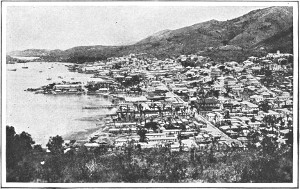
VIEW OF CHARLOTTE AMALIE, ST. THOMAS
MENTOR GRAVURES
ST. THOMAS HARBOR BEFORE THE DANISH FLAG CAME DOWN · ST. THOMAS, DANISH GOVERNMENT BUILDING, NOW U.S. MARINE HEADQUARTERS · CHARLOTTE AMALIE, ST. THOMAS · CHRISTIANSTED, ST. CROIX · STREET IN FREDERIKSTED, ST. CROIX · COUNTRY ROAD, ST. CROIX
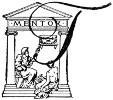
The Virgin Islands formerly known as the Danish West Indies were purchased by the United States for the apparently exorbitant sum of $25,000,000. While the group comprises more than fifty islands, but three are inhabited. These are St. Thomas, Santa Cruz or St. Croix (sahn krwah), and St. John.
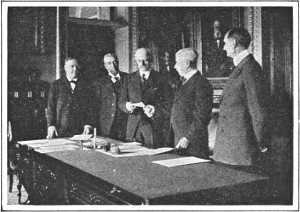
Copyright by Clinedinst Studio
TRANSFER OF THE DANISH WEST INDIES TO THE UNITED STATES
Secretary Lansing handing Constantin Brun, the Danish Minister at Washington, a Treasury Warrant for $25,000,000. The others in the group are Secretary Daniels, Secretary McAdoo, and Rear-Admiral James H. Oliver, first appointee to the Governorship of the Virgin Islands of the United States of America
Denmark received from the United States an average price of $295 per acre. Alaska was purchased at a cost of two cents per acre, and the Philippine Islands cost us about twenty-seven cents per acre. For strategic, economic and political reasons the Virgin Islands are worth far more to us than their purchase price. We were in need of a naval base to protect the Panama Canal, and the harbor at St. Thomas provides the best naval station in the West Indies.
The islands were discovered by Columbus in 1493, on his second voyage to the New World. Since then the inhabitants have been under Spanish, British, French, Dutch and Danish rule. For over two hundred years the Danish flag has flown above these islands of the Virgin group. Repeatedly the United States has tried to acquire them. In 1865 Secretary Seward offered five millions of dollars, which was increased two years later to $7,500,000. Again, in 1901, negotiations were entered into with Denmark, but Germany intervened, and once more the project failed.
A price was finally agreed upon, and the transfer of the islands took place March 31, 1917. The ceremony was most impressive, though Governor Oliver, appointed by President Wilson, could not arrive in time to take part in it. Commander Pollock, of the gunboat Hancock, was at Santo Domingo and was ordered to proceed at once to St. Thomas and take possession in the name of the United States. He arrived on the day of the ceremony, and was met by the Danish governor, Danish officials, and officers and marines of the Danish gunboat Valkyrie. In the presence of a large assemblage the Danish flag came down after nearly two and a half centuries of rule, and the Stars and Stripes was raised over the former Danish Government buildings, over forts, and on various private flagstaffs. Many of the Danes were in tears. A number of them had been born on the islands and knew no other home. To them it was a sad event, but practically all realized that the transfer was best for the people generally and for the future of the islands.
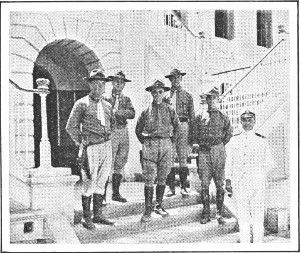
MAJOR SALLADAY AND STAFF
Commanding the United States Marines stationed at St. Thomas—on the steps of the barracks, Charlotte Amalie
The Commerce and People
Besides Charlotte Amalie, a town of about 8,000 inhabitants, there are a few scattered settlements on the island of St. Thomas. Some years ago the harbor was a free port and Charlotte Amalie enjoyed a considerable commerce. Immense warehouses were built, and merchants from Central and South America came to the island to purchase merchandise. When the port was no longer free, its commerce gradually dwindled and the harbor was almost deserted. Ships called only to go into drydock or to coal. It now remains for Uncle Sam to restore its former trade with our sister republics to the south.
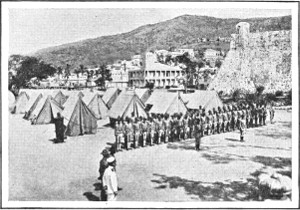
CAMP OF AMERICAN MARINES
Beneath the walls of the fort on the water-front, Charlotte Amalie
Little or nothing grows on the island of St. Thomas, and from an agricultural standpoint it offers but few opportunities. Its inhabitants, aside from about two hundred whites, are all negroes. The Danes were unable to teach them their language, and practically all speak English with that peculiar drawl that has become familiar to us in Jamaica and other islands in the West Indies. The blacks welcome the coming of Uncle Sam. They look upon us as a Santa Claus, who will bring them untold blessings and wealth beyond their dreams. They are a simple, childlike people, with bodies of men and women but with the intellect of the average child.
Charlotte Amalie
Charlotte Amalie is a clean little town with regular streets, and buildings built of stone and brick faced with cement. The Danes are a cleanly, orderly people, and this is evident in the appearance of the towns on the islands.
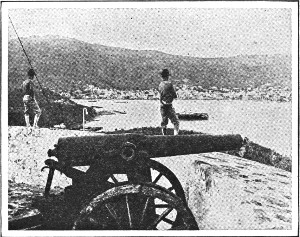
OLD DANISH FORT, ST. THOMAS HARBOR
Hurricanes are frequent, and at times do great damage. A storm of several years ago unroofed many of the houses, tore down palm trees and destroyed most of the foliage. Traces of the hurricane may still be seen, but its effect is gradually being obliterated.
Many steamers have been wrecked on these islands. Among numerous sailors stranded on St. Thomas was a Frenchman named Louis Monsanto. He founded on the shore of Krum Bay what he calls the graveyard of ships. Lying about are several odd figureheads that once adorned the bows of lost boats. Each has its story of thrilling escapes and tragic loss of life to awe the listener.
Marines now police the island, and to them has been entrusted the task of restoring order, mounting guns for the protection of the harbor, and firmly establishing American rule.
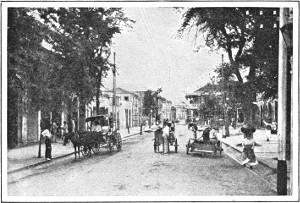
VIRGIN ISLAND TAXI-CAB AND EXPRESS SERVICE
An Island Bluebeard
These islands were once infested by pirates; in Charlotte Amalie we see Bluebeard’s and Blackbeard’s castles. An English pirate who married a woman from Charlotte Amalie went away on one of his piratical expeditions, entrusting to his wife a small box which he told her not to open unless he did not return in six months. After two months, woman’s curiosity got the better of her and she opened the box. She found therein just seven letters, but they were seven compromising letters written by women of Charlotte Amalie. She did not kill her husband, instead she invited the women to an afternoon tea at her home and poisoned all seven. So, you see it was not, in this case, the man who was the “bluebeard,” but the wife—a sort of bluebearded lady. She was arrested, tried and convicted, and was condemned to be burned at the stake. The eventful day arrived. Fagots were piled high about her, the torch was about to be applied, when the pirate ship appeared in the harbor, the pirate and his crew came ashore, and the wife was rescued. Then she sailed away with her husband, and they “lived happily ever after.”
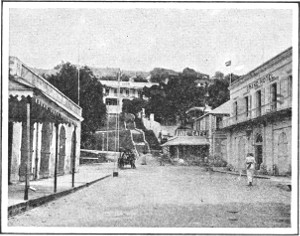
ENTRANCE OF THE GRAND HOTEL, CHARLOTTE AMALIE
From “The Virgin Islands of the United States of America,” by Luther K. Zabriskie, G. P. Putnam’s Sons, Publishers
St. John and St. Croix
The smallest of the inhabited islands is St. John. The few people living there are employed in picking bay leaves. The bay tree thrives on the island, and the oil obtained from its leaf is used in the making of bay rum.
The largest of the islands is St. Croix. It is about twenty-one miles in length and from four to fourteen miles in width. Rich and fertile, its soil produces chiefly sugar, a product capable of still further industrial development. The principal difficulty encountered is in obtaining good water. There is but one stream on the island, and except for the water from this stream the people must depend on rain water stored during the rainy season. One of the first duties that we have before us is the boring of artesian wells, as all the islands are in great need of good water for drinking and commercial purposes.
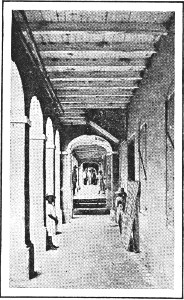
COVERED WALK
Christiansted, St. Croix
There is a primitive sugar mill on the island of St. Croix that is owned by Danes. One of the owners told me that the day the islands were transferred to the United States the negro employees formed a union and struck. They lost no time in availing themselves of the advantages that organized labor enjoys in a great republic.
The seat of government of this island is Christiansted, a town of about 4500 people. It is a neat, substantial little place, with covered colonnades extending through the business section of the town. These covered passageways enable one to walk about without being exposed to the rays of a tropical sun.

“GOVERNMENT HILL,” CHARLOTTE AMALIE
Showing Administration Building (upper right-hand) and Governor’s House (flying American flag)
It was from Frederiksted, the chief port of St. Croix, that Alexander Hamilton came to America. Born on the island of St. Nevis, his mother died when he was still an infant. He was then sent to an aunt who lived on St. Croix, and it was there that he gave evidence of the brilliant mind that in later years made him one of the most conspicuous figures in American history. It is a strange coincidence that over a hundred years after Hamilton left St. Croix it should come into possession of the nation he served so brilliantly. What might George Washington, “The Father of his Country,” say if he could know that the birthplace of the young West Indian attorney, to whom he looked for legal counsel, was now part of the great republic in whose establishment each of them had such an important share?

From “The Virgin Islands,” by Luther K. Zabriskie, G. P. Putnam’s Sons, Publishers
PANORAMIC VIEW SHOWING PLANTATION ON THE ISLAND OF ST. CROIX
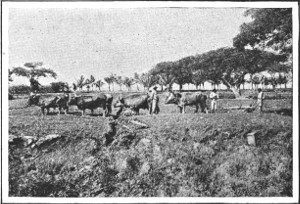
PLOUGHING ON ST. CROIX
There is but one paved highway on St. Croix, and that extends from Christiansted to Frederiksted at the west end of the island. A macadam road twenty-one miles in length connects the two towns, and over this highway passes practically all the traffic on the island. Here we see a curious procession of natives driving all kinds of queer vehicles drawn by diminutive ponies or donkeys.
Women carry upon their heads loads that would stagger the average man. They are able to balance almost anything, and one sees them carrying boxes, barrels, and even pianos, although the latter require about four women to balance their weight.
Agriculturally, St. Croix offers a good field for development. Cotton as well as sugar can be grown profitably, and, with modern American methods, its products can be materially increased.
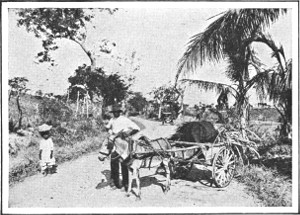
ON A SUNNY ROAD, ST. CROIX
System of Education
When the Americans first took possession there was much confusion. Danish law conflicted with American law, Danish customs differed from American customs, there was a Danish postmaster and an American postmaster; but these things are now straightened out and order has been completely restored.
The Danish method of instruction, which has long been in use, has been continued by the United States. The system differs from our own in that the schools are in session practically the year round, and religious training is required. The religious training in the schools will be discontinued, but otherwise the Danish method will obtain.
Virgin Islanders pride themselves on their low percentage of illiteracy. Only about two per cent. of the inhabitants are unable to read and write.
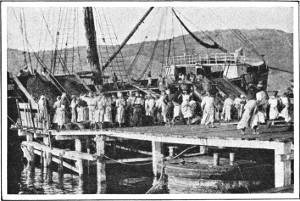
LONGSHOREWOMEN COALING A SHIP
St. Thomas Harbor
The Importance of St. Thomas
Commercially, the island of St. Thomas is destined to play the most important part of all the group, as it is a favored way-station on the route from European ports to the Panama Canal. Its lost trade can be regained, and it may be possible for American manufacturers to display samples of their wares in especially built ware-rooms at Charlotte Amalie. This would enable the merchants of Central and South America to make their purchases again as they once did. It would obviate the necessity of a long journey to New York, and the port of St. Thomas would be a convenient place in which to see American-made goods and place orders.

THE FORT ON THE HILL ABOVE CHARLOTTE AMALIE
Now an American jail
The gold paid by the United States to Denmark for the Virgin Islands weighed 48 tons. Like everything else, the islands have gone up in price since the first negotiations undertaken, fifty years ago, but it was necessary for us to have them, as with St. Thomas in our possession and fortified no foreign power without a naval base in this part of the world would dare attack the Panama Canal without first capturing St. Thomas. Without it they would leave a fortified base in their rear, an extremely dangerous situation for an attacking force.
The value of the harbor of St. Thomas and its strategic advantages have been recognized since the days of the Spanish buccaneers. Once the headquarters for ships sailing under the black flag, the memories of those days will always form a romantic and fascinating side of the life that was. Today there are modern harbor works, floating docks, marine slips and wharves provided with electric cranes, oil reservoirs, coal depots, fresh-water tanks, machine shops, and many other things that contribute to the commercial advantage of St. Thomas as a port of call.
We must not overlook the political importance of extending American jurisdiction over islands situated in the Caribbean Sea. The possibility of a change of sovereignty of any of the islands under foreign jurisdiction is of grave concern to this country.
The Monroe Doctrine, a settled national policy, would have caused this country to look with disfavor upon the acquisition of the Danish West Indies by any other power. The treaty of cession of these islands to the United States is therefore a matter of no small moment.
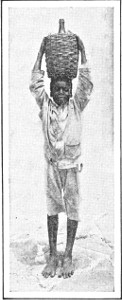
A BAY RUM CARRIER
Island of St. John
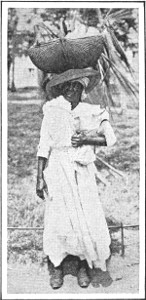
A NATIVE ON THE WAY HOME FROM MARKET
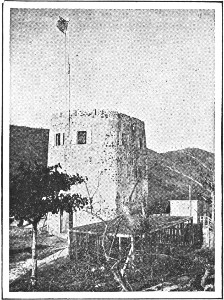
“BLUEBEARD’S CASTLE,” CHARLOTTE AMALIE
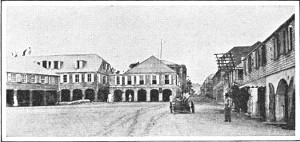
PUBLIC SQUARE, CHRISTIANSTED, ST. CROIX
Previous to the purchase, Rear Admiral Casper F. Goodrich thus defined the advantages of the transfer in an interview in the New York Times. “Were the Danish West Indies in the possession of an enemy, what interests of ours would be menaced? Let us seek the answers to this momentous question. From them, as a base, to Charleston, our nearest important Atlantic harbor, is about 1200 miles; to Norfolk about 1300 miles—distances easily covered in three or four days by a fleet which could fight an action and return with plenty of fuel left in the bunkers. Moreover, raiding operations therefrom, could, and doubtless would, seriously interfere with, if they didn’t wholly interrupt, our foreign commerce, even at remote points, such as New York, Boston and Portland. In the other direction lies Colon, a little more than one thousand miles away from St. Thomas. It is against Colon that an inimical campaign would more possibly be directed. The possession of this gateway to the Pacific would restore the conditions of the war with Spain, when the Oregon had to circumnavigate the whole of South America in order to join Sampson off Santiago de Cuba.
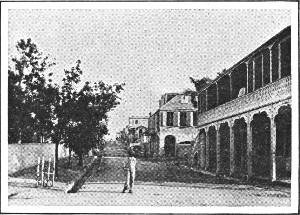
STREET IN FREDERIKSTED
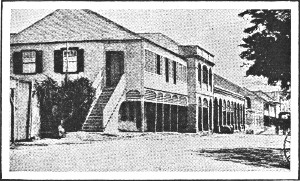
HOUSE WHERE ALEXANDER HAMILTON LIVED AS A BOY, FREDERIKSTED, ST. CROIX
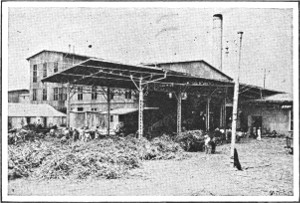
DANISH SUGAR MILL, ST. CROIX
“It is evident that a foreign nation endeavoring to acquire the Danish West Indies could in fact have no mere commercial or profitable colonial aim in view. There is but one harbor in the group that is especially fit for a naval base—Charlotte Amalie, on the south side of St. Thomas. By skill and care it could be made to accommodate a fleet large enough to occasion us grave concern. From a secure harbor for merchant steamers to a naval establishment and a military outpost, the path is neither hard nor long. It is wiser, however distasteful, to forestall any such manoeuver by a foreign power by buying the islands ourselves. We do not relish the idea of such a thorn in our side, such a threat to neighboring Porto Rico, to our naval station at Guantanamo (only 300 miles distant), to that at Key West (1000 miles distant), to the free navigation of the Caribbean Sea, and the Mona and Windward Passages (between Porto Rico and Haiti, Cuba and Porto Rico, respectively), or to our Gulf cities. Thus it appears, north, east, south and west, these islands are a most valuable point d’appui for any European government wishing to quarrel with us. It is, therefore, in the highest degree essential that we spare no effort to prevent their falling into unfriendly hands.”
Transportation
Climatically the Virgin Islands offer much to attract the tourist as a winter resort. They need first-class hotels, to be built and managed by competent Americans. There is no reason why the islands should not become popular with the tourist as soon as suitable accommodations have been provided.
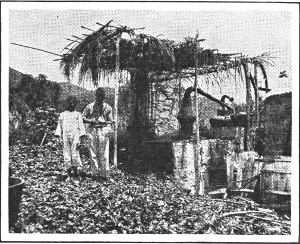
BAY OIL STILL
From “The Virgin Islands,” by Luther K. Zabriskie, G. P. Putnam’s Sons, Publishers
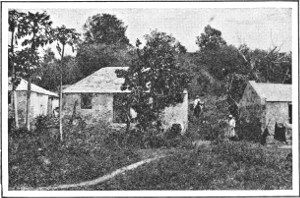
LABORERS’ HOMES ON A ST. CROIX PLANTATION
From “The Virgin Islands,” by Luther K. Zabriskie, G. P. Putnam’s Sons, Publishers
Situated 1440 miles south of New York and 1025 miles from Colon, the northern entrance to the Panama Canal, the islands are ideally placed for a short sea voyage. The population in recent years has been diminishing, because of the loss of trade and the consequent falling-off of the number of ships in the harbor. At one time there were 46,000 people on the islands; in 1911, the number had dwindled to 27,000, and the present population is said to approximate this figure.
The only means of transportation on St. John is by horseback. As the island is very hilly, the roads are not suitable for vehicles. On St. Thomas there are about fifteen miles of good roads, traversed by numerous carriages and a few automobiles. St. Croix boasts one hundred miles of roads, but few of these are paved.
We include in our West Indies possessions not only some of the Virgin Islands, but Porto Rico. Porto Rico, however, is no more American today than when we first went to the island. But the Virgin Islander welcomes the United States. The circumstances attending the purchase and transfer of the islands were most auspicious, and we foresee only the happiest outcome from the relations between the natives and the United States.
SUPPLEMENTARY READING
| THE VIRGIN ISLANDS OF THE UNITED STATES OF AMERICA | By Luther K. Zabriskie |
| THE VIRGIN ISLANDS | By T. H. N. de Booy and J. T. Faris |
| DANISH WEST INDIES | By W. C. Westergaard |
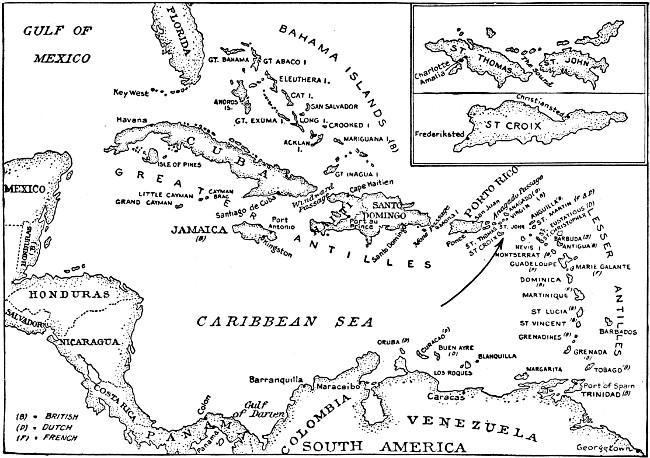
MAP SHOWING LOCATION OF VIRGIN ISLANDS
When Mr. E. M. Newman, who is now in Europe, returns, he will bring pictures and information that will mean a great deal to all the readers of The Mentor. Mr. Newman had intended to resume his South American series—which has been appearing in The Mentor—and was about to sail to the southern continent when he was summoned to Washington and commissioned by the United States Government to go over and make a special study of war conditions in England, France, and Italy. Mr. Newman’s objective is not the trenches—there are plenty of war correspondents and battle photographers. His mission is a distinctly new and important one. He is to make a record, in pictures and text, of the living conditions of the people in war time as he observes them in the allied countries. When he returns, this material will be put at once before the public in a series of lectures, the purpose being to make clear to Americans just what war means to those that are not “out there,” but are doing their bit in the home city, town, village, or farm district. Naturally, this material will have tremendous vital interest to all of us in the United States who are watching and wondering what war is going to mean in our daily lives and occupations. “I hope particularly,” said Mr. Newman, “to illustrate the conservation of human power that makes possible the release of able bodied men to the war with the least disturbance to commerce. The object is to bring back to the United States a graphic presentation of what can be done and what should be done to permit us to utilize every ounce of our strength for the successful prosecution of the war.”
The Mentor will publish Mr. Newman’s material in three articles, entitled “England in War Time,” “France in War Time,” “Italy in War Time.” We expect to have these important articles ready for publication in the Fall—the dates will depend upon the time of Mr. Newman’s return. On the opposite page we print some interesting information just received from him.

W. D. Moffat
Editor
War Conditions in England
Mr. Newman sends us word from London that air raids there are strengthening instead of weakening the morale of the British. Few Londoners ever think of hiding in the bomb-proof cellars when the enemy planes arrive, and when the warning signal is given the entire population rushes to the roofs of buildings and other points of vantage to watch the fight. Mr. Newman witnessed a night air raid on London. “For fear that I might miss something,” he writes, “I went up on the roof of a building and watched the searchlights and saw the flash of the many anti-aircraft guns. The boom of cannon and the whirr of the machines was an inspiring spectacle. I must say that the British airmen are perfectly wonderful. I watched with intense excitement several battles in the air, during which I saw flashes of fire from the machine guns which the British flyers were using to destroy the German planes. Seven of the invaders were brought down, and while I regret that any got away, I think the result was most gratifying. Were it not for the loss of life and the destruction of property, I would like to see another raid.”
Mr. Newman, accompanied by a British major, made a tour of the English provinces, where millions of women are engaged in war work. “The women of England,” writes Mr. Newman, “are working very hard; they are doing work that few people would believe women capable of performing. I have a picture of women workers in Glasgow forging steel ingots. Women make shells of every size, run huge machines of every description, build hydro and aeroplanes, do carpentry work, blacksmithing, painting, and, in fact, almost every phase of labor formerly done by men. I have obtained pictures of the Land Army composed of women doing all kinds of heavy farm work, such as harnessing horses, and ploughing. In Edinburgh I photographed some quaint street scenes showing the motor buses with huge gas bags on top to take the place of petrol. I went to Ilford, where I photographed girls working on engines as stokers, oilers and cleaners. The American Y.M.C.A. Hut in London is a very busy center, where our boys are entertained and cared for. I have a pretty picture of an American girl making flapjacks for some of our sailor boys. Other pictures I have show girl chauffeurs, ‘Penguins’ or Royal Air Force Girls, girl messengers, porters, and a girl driving an electric truck. Londoners are ‘carrying on’ cheerfully, and at the same time are enjoying theaters and other such pleasures as life in wartime permits.”
THE MENTOR
The Wealth of The Mentor
- 1 Beautiful Children in Art, by Kobbé.
- 2 Makers of American Poetry, by Mabie.
- 3 Washington the Capital, by Elmendorf.
- 4 Beautiful Women in Art, by Willing.
- 5 Romantic Ireland, by Elmendorf.
- 6 Masters of Music, by Henderson.
- 7 Natural Wonders of America, by Elmendorf.
- 8 Pictures We Love to Live With, by Huneker.
- 9 The Conquest of the Peaks, by Fay.
- 10 Scotland, the Land of Song and Scenery, by Elmendorf.
- 11 Cherubs in Art, by Kobbé.
- 12 Statues with a Story, by Lorado Taft.
- 13 The Discoverers, by Albert Bushnell Hart.
- 14 London, by Elmendorf.
- 15 The Story of Panama, by Bonsal.
- 16 American Birds of Beauty, by E. H. Forbush.
- 17 Dutch Masterpieces, by Van Dyke.
- 18 Paris, the Incomparable, by Elmendorf.
- 19 Flowers of Decoration, by H. S. Adams.
- 20 Makers of American Humor, by Burges Johnson.
- 21 American Sea Painters, by Arthur Hoeber.
- 22 The Explorers, by Hart.
- 23 Sporting Vacations, by Beard.
- 24 Switzerland, the Land of Scenic Splendors, by Elmendorf.
- 25 American Novelists, by Mabie.
- 26 American Landscape Painters, by Samuel Isham.
- 27 Venice, the Island City, by Elmendorf.
- 28 The Wife in Art, by Kobbé.
- 29 Great American Inventors, by Brace.
- 30 Furniture and Its Makers, by Richards.
- 31 Spain and Gibraltar, by Elmendorf.
- 32 Historic Spots of America, by McElroy.
- 33 Beautiful Buildings of the World, by Ward.
- 34 Game Birds of America, by E. H. Forbush.
- 35 The Contest for North America, by Hart.
- 36 Famous American Sculptors, by Lorado Taft.
- 37 The Conquest of the Poles, by Rear Admiral Peary.
- 38 Napoleon, by Ida M. Tarbell.
- 39 The Mediterranean, by Elmendorf.
- 40 Angels in Art, by Van Dyke.
- 41 Famous Composers, by Henry T. Finck.
- 42 Egypt, the Land of Mystery, by Elmendorf.
- 43 The Revolution, by Albert Bushnell Hart.
- 44 Famous English Poets, by Mabie.
- 45 Makers of American Art, by J. T. Willing.
- 46 The Ruins of Rome, by Botsford.
- 47 Makers of Modern Opera, by H. E. Krehbiel.
- 48 Two Early German Painters—Dürer and Holbein, by F. J. Mather, Jr.
- 49 Vienna, the Queen City, by Elmendorf.
- 50 Ancient Athens, by Botsford.
- 51 The Barbizon School, by Hoeber.
- 52 Abraham Lincoln, by Hart.
- 53 George Washington, by McElroy.
- 54 Mexico, by Frederick Palmer.
- 55 Famous American Women Painters, by Arthur Hoeber.
- 56 The Conquest of the Air, by Woodhouse.
- 57 Court Painters of France, by Coffin, N. A.
- 58 Holland, by Elmendorf.
- 59 Our Feathered Friends, by E. H. Forbush.
- 60 Glacier National Park, by Hornaday.
- 61 Michelangelo, by Cox.
- 62 American Colonial Furniture, by Esther Singleton.
- 63 American Wild Flowers, by Eaton.
- 64 Gothic Architecture, by Ward.
- 65 The Story of the Rhine, by Elmendorf.
- 66 Shakespeare, by Mabie.
- 67 American Mural Painters, by Hoeber.
- 68 Celebrated Animal Characters, by Hornaday.
- 69 Japan, by Elmendorf.
- 70 The Story of the French Revolution, by Albert Bushnell Hart.
- 71 Rugs and Rug Making, by Mumford.
- 72 Alaska, by Browne.
- 73 Charles Dickens, by Mabie.
- 74 Grecian Masterpieces, by Lorado Taft.
- 75 Fathers of the Constitution, by Albert Bushnell Hart.
- 76 Masters of the Piano, by Finck.
- 77 American Historic Homes, by Singleton.
- 78 Beauty Spots of India, by Elmendorf.
- 79 Etchers and Etching, by Weitenkampf.
- 80 Oliver Cromwell, by Albert Bushnell Hart.
- 81 China, by Elmendorf.
- 82 Favorite Trees, by Hornaday.
- 83 Yellowstone National Park, by Elmendorf.
- 84 Famous Women Writers of England, by Mabie.
- 85 Painters of Western Life, by Hoeber.
- 86 China and Pottery of Our Forefathers, by Esther Singleton.
- 87 The Story of The American Railroad, by Albert Bushnell Hart.
- 88 Butterflies, by Holland.
- 89 The Philippine Islands, by Worcester.
- 90 Great Galleries of the World—the Louvre, by Van Dyke.
- 91 William M. Thackeray, by Mabie.
- 92 The Grand Canyon, by Elmendorf.
- 93 Architecture in American Country Homes, by Aymar Embury.
- 94 The Story of the Danube, by Albert Bushnell Hart.
- 95 Animals in Art, by Kobbé.
- 96 The Holy Land, by Elmendorf.
- 97 John Milton, by Mabie.
- 98 Joan of Arc, by Ida M. Tarbell.
- 99 Furniture of the Revolutionary Period, by Esther Singleton.
- 100 The Ring of the Nibelung, by Finck.
- 101 The Golden Age of Greece, by Botsford.
- 102 Chinese Rugs, by Mumford.
- 103 The War of 1812, by Albert Bushnell Hart.
- 104 Great Galleries of the World—The National Gallery, London, by Van Dyke.
- 105 Masters of the Violin, by Finck.
- 106 American Pioneer Prose Writers, by Mabie.
- 107 Old Silver, by Esther Singleton.
- 108 Shakespeare’s Country, by William Winter.
- 109 Historic Gardens of New England, by Mary H. Northend.
- 110 The Weather, by C. F. Talman.
- 111 American Poets of the Soil, by Johnson.
- 112 Argentina, by Newman.
- 113 Game Animals of America, by Hornaday.
- 114 Raphael, by Van Dyke.
- 115 Walter Scott, by Mabie.
- 116 The Yosemite Valley, by Elmendorf.
- 117 John Paul Jones, by Albert Bushnell Hart.
- 118 Russian Music, by Finck.
- 119 Chile, by Newman.
- 120 Rembrandt, by Van Dyke.
- 121 Southern California, by C. F. Lummis.
- 122 Keeping Time, by Talman.
- 123 American Miniature Painting, by Mrs. Elizabeth Lounsbery.
- 124 Gems, by Esther Singleton.
- 125 The Orchestra, by Henderson.
- 126 Brazil, by E. M. Newman.
- 127 The American Triumvirate, by A. B. Hart.
- 128 The Madonna and Child in Art, by Van Dyke.
- 129 The Story of the American Navy, by Barnes.
- 130 Lace and Lace Making, by Esther Singleton.
- 131 American Water Color Painters, by Kobbé.
- 132 Peru, by E. M. Newman.
- 133 The Story of the American Army, by Hart.
- 134 Our Planet Neighbors, by Harold Jacoby.
- 135 The Story of Russia, by Leo Pasvolsky.
- 136 The Story of the Hudson, by A. B. Hart.
- 137 Prehistoric Animal Life, by Dr. Matthew.
- 138 Hawaii, by E. M. Newman.
- 139 Earthquakes and Volcanoes, by Talman.
- 140 The Canadian Rockies, by Ruth Kedzie Wood.
- 141 Corot, by Elliott Daingerfield.
- 142 Bolivia, by E. M. Newman.
- 143 Russian Art, by William A. Coffin.
- 144 The American Government, by A. B. Hart.
- 145 Christmas in Picture and Story, by Singleton.
- 146 The Picture on the Wall, by Weitenkampf.
- 147 Lafayette, by Albert Bushnell Hart.
- 148 American Composers, by Henry T. Finck.
- 149 The Luxembourg Gallery, by Wm. A. Coffin.
- 150 Julius Caesar, by Prof. George W. Botsford.
- 151 The Incas, by Osgood Hardy.
- 152 Rodin, by Emile Villemin.
- 153 The Columbia River, by Ruth Kedzie Wood.
- 154 The Story of Coal, by C. F. Talman.
- 155 Benjamin Franklin, by A. B. Hart.
- 156 The Forest, by Henry S. Graves.
- 157 Metropolitan Museum of Art, by S. P. Noe.
- 158 The Cradle of Liberty, by A. B. Hart.
- 159 Mt. Rainier National Park, by Belmore Browne.
- 160 Photography, by Paul L. Anderson.
You need only mail a postcard—listing ten or more of the numbers opposite the titles—and we will send the selections of your choice, all charges paid. Ten copies, at 20 cents each, may be paid for on easy installments of but $1.00 a month for two months. We urge you to mail the card to us today.
THE MENTOR ASSOCIATION, 114-116 East 16th Street, New York City
MAKE THE SPARE
MOMENT COUNT


